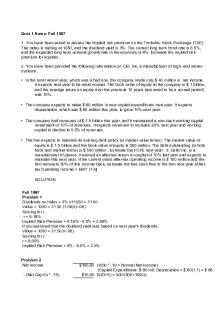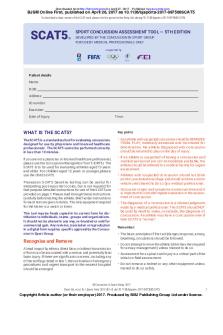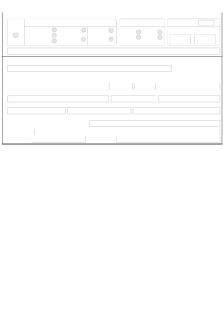306 Final Merged Report PDF

| Title | 306 Final Merged Report |
|---|---|
| Course | Entrepreneurship |
| Institution | University of Dhaka |
| Pages | 52 |
| File Size | 1.7 MB |
| File Type | |
| Total Downloads | 38 |
| Total Views | 180 |
Summary
Report...
Description
Pure Milk Drop
Course Name: Entrepreneurship and Project Development Course Code: F-306
Submitted to: Md Saimum Hossain, CFA Assistant Professor Department of Finance Faculty of Business Studies University of Dhaka.
Submitted by: Group Number: 07 Section: A BBA 23rd Batch Department of Finance Faculty of Business Studies University of Dhaka
Date of Submission: 3rd December, 2019
Group Profile Serial Number 1
Name
ID Number
Sabrina Rahman Supti
23-028
2
Md Noornobi Sheikh
23-112
3
Israt Jahan
23-138
4
Pikashu Podder
23-044
5
Resan Ahmed
23-025
6
Rudra Saha
23-080
7
Saima Khan Asmita
23-034
8
Meraj Hossain Khan
23-059
9
Farzana Fariha
23-095
Remarks
Acknowledgement At the very beginning, we would like to express our deepest gratitude to the almighty Allah for giving us the knowledge, strength and ability to finish the task properly. Completion of anything requires supports from various sources. We are very much fortunate to get the sincere guidance and supervision from a number of people. We would like to express our profound gratitude to our Supervisor, Md Saimum Hossain, CFA, associate professor, his continuous guidance, individual suggestions, constructive criticism, continuous encouragement and unfailing enthusiasm throughout the process of completion of this thesis program which helped us a lot to understand about a business idea and its feasibility. We would like to give special thanks and greetings to our fellow friends for giving us some required information, valuable advices and suggestions to complete the thesis in a comprehensive manner. We are grateful for the overwhelming love and endless inspiration of our mother and our entire family. We would like to acknowledge the cordial help and participation of all the above people from the bottom of our heart.
Table of Contents Executive Summary........................................................................................................................vi 1.
Problem and Market Opportunity.............................................................................................7
2.
Solution....................................................................................................................................7
3.
Competitive Landscape............................................................................................................8
4.
Industry Analysis......................................................................................................................8 Porter’s Five Forces Model:.........................................................................................................9
5.
Marketing Plan.......................................................................................................................10 5.1.
STPD...............................................................................................................................10
5.2.
Integrated Marketing Communications...........................................................................11
6.
Human Resource Plan............................................................................................................11
7.
Legal matters..........................................................................................................................13
8.
Risk Analysis..........................................................................................................................14
Appendix 1 (Problem and Solution)..............................................................................................16 Appendix 2 (Competitive Landscape)...........................................................................................17 Appendix 3 (Industry Analysis).....................................................................................................18 Appendix 5 (Financial planning):..................................................................................................20 Appendix 6 (Legal matters)...........................................................................................................36 Appendix 7 (Documents)...............................................................................................................39 Appendix 8 (Album)......................................................................................................................49 Reference.......................................................................................................................................52
Executive Summary We are trying to provide contamination-free milk through home delivery as core value proposition and Collecting & Providing milk according to the subscription and easily useable quality as augmented value through our business. To ensure the value proposition we need to perform several key activities. Collection of milk, storing and packaging it, collect orders from customers directly and support other activities are the key activities of our firm. To perform key activities, we need resources. Human resources, mobile applications, strong supply chains, and free delivery service are the key resources. Our key partners are local agents who will collect milk for us and the Asian Plastic Container Industry who will be our bottle supplier. Our targeted customers (including consumers) are the people of our three selected areas Dhanmondi, Mirpur, and Mohammadpur, aged between 15-45 years and who are willing and able to buy our product. Through our survey 76% people from that area are willing to buy our product. We will reach our customers by those channels: Mobile application, toll-free number, and spot sale. We will maintain customer relationships by awarding them with leaflet, social media page, phone call, direct persuasion, nurture them by application based service and transactional personal assistance, and grow customers by providing home delivery service and discount offers. Our start-up cost will be around 70 lacs in which fixed cost is 7,40,000 and variable cost per liter is 54 taka and for promotion and marketing 3,00,000. Customers will order through app by package subscription which can be 3 days, 7 days, 15 days and 30 days. We will sale at 80 takas per liter of milk.
vi
1. Problem and Market Opportunity Milk is a common food, which is consumed by almost every person around the world starting from children to old persons. Because milk is considered a nutritious food, people try to drink milk regularly as a habit willingly or unwillingly. But today milk is no longer safe for human health because milk is repeatedly being contaminated. Recently, the National Food Safety Laboratory (NFSL) has found several toxic elements like lead, pesticides and harmful chemicals in cow milk and fodder that can cause cancer and other ailments after consumption. The laboratory had collected the samples of all brands of packaged milk from big food stores and directly from dairy farms and found the presence of pesticides, lead, chromium, tetracycline, enrofloxacin, crocin and aflatoxin between 9 and 96 percent. Besides, microbiological impurities were found in 51 percent of curd samples of different brands collected from sweet shops while one sample contained lead above the permitted level. The surveyors also collected 31 samples of all brands of packaged milk, both imported and locally produced, from the market. They found that 30 percent of the samples contained lead above permitted levels, while 66-80 percent of the samples contained microbiological impurities.
There are some factors that are affecting production and consumption Currently, in Bangladesh, there are 242.38 lakhs of cattle and 14.96 lakhs of buffalo. The current growth rate of cattle is 0.63 percent and for buffalo it is 0.47 percent. The current growth rate for production of milk is 5.55 percent. Currently, in Bangladesh approximately 0.50 million metric tons cattle feed is available and the current growth rate of animal feed industry is 9 percent approximately, which is affecting the production of milk.
According to WHO standards every person should consume at least 250 ml of milk per day to remain healthy and fit. At present, there is a demand for 152.02 lakh metric tons of milk per year in Bangladesh. But the existing supply of milk is only 99.23 lakh metric tons. Particularly in Mohammadpur, Mirpur and Dhanmondi 921,068 people have a demand for 82,896,156 liters per year. But currently there is supply of only 948,700 liters of milk per year. The annual demand for milk is growing per year, the current growth rate for demand for milk is 10 percent.
7
So, currently, there is a big gap of 52.79 lakh metric tons of milk, which is not supplied by the existing market. Also the contamination of milk is on the rise, which needs to be solved.
2. Solution The problem of contamination of milk and the current growing demand gap can be solved by supply of pure raw milk from authentic sources, which will ensure the purity and sufficiency of milk. We through our business “Pure Milk Drop” are going to solve this problem by supplying pure raw milk directly to customers.
3. Competitive Landscape Pure milk drop has 4 direct competitors and 14 indirect competitors. Among direct competitor there exist 4 firms which occupied 65% shares of raw milk market in Mohammadpur, Dhanmondi, and Mirpur. They are Agro hub, Padma dairy, milk hut, hygienic dairy and 15% of the raw milk market is occupied by grocery shop which sells raw milk and organic factory. In the segment of indirect competitors there are Pran Milk, Milk Vita, Aarong dairy and farm fresh. We have advantage of Nutritional value, Freshness, Social consciousness then our direct and indirect competitor than local firms, grocery shops, and organic factories. Those things also help us to create our product differentiation and competitive advantage. At the Taste and pricing segment we have disadvantages then Grocery shops. In one sector we have disadvantage than our competitor which is Branding.
4. Industry Analysis Bangladeshi dairy industry produces 9.4 million tons of milk against the requirement of 15.04 million tons of milk in a year which is 63% of the requirement. The average growth rate of the dairy industry is 5.55% currently with the highest growth rate of 46.53% in 2012-13 and the lowest in 2017-18. There are milk supplying companies that are above 10 in number. The major players in the market are Milk Vita (52%), Aarong Dairy (21%), Pran Milk (10%) Rangpur Dairy and many other local suppliers (17%). The gross profit margin and the net profit margin of the dairy industry are 22.81% and 15.79% respectively. The value chain of the dairy industry is as follows: Inbound Logistics 1. Dairy Farmers 2. Primary Cooperatio n-Dairy cooperative society,
Operations 1. Milk Chilling & Processing Center 2. Central Preservatio n Center
Outbound Logistics
Marketing & Sales
1. Wholesalers & Commission Agents
1. Social Media
2. Local Distributors
4. Leaflets distribution
2. Newspapers 3. Television advertisement
Services 1. Personal assistance 2. Toll free telephone 3. Improved home delivery services
profitability
There are some laws which are controlling the operations and activities of the milk industry. Some of these acts are-Food Safety Act-2013(Section-29,31,34,45,46-1,2), Bangladesh Standards and Testing Institution Act-2008(BDS 851), The Penal Code -1860(Act LV of 1860), The Essential Commodity Act-1957, Bangladesh Standards, and Testing Institution Ordinance1985(Amendment 2003). The demand for milk is influenced by some factors which have an impact on the decision of the direct consumers for collecting milk. Such as: 1. Health Consciousness: The people of Bangladesh are moderately conscious about their health. Only conscious people are eager to consume milk for their health benefits. 2. Product Type: Milk is a must-have product. Being influenced by this sense, some people want to consume milk. 3. Purchasing Power: The purchasing power of the consumers highly influences the milk consumption decision The supply of milk is also influenced by some factors like: a. Production: Bangladeshi dairy industry produces/supplies 9.4 million tons of milk in a year which can be increased by adding more farms to the dairy industry. b. Process: the milk which is supplied for the consumption is not free from the preservatives and the contamination. c. Transportation Cost: As the transportation facilities in Bangladesh is not so good, the transportation cost becomes a bit high. d. Suppliers: The established dairy companies in Bangladesh are more than 10 in number and there are a lot of local milk suppliers.
Porter’s Five Forces Model: Dairy industry can be analyzed based on Porter's five forces model. 1. The threat of Substitutes: Milk is a must-have product. There is no alternative to milk. 2. The threat of New Entrants: Milk industry faces an increasing economy of scale because average cost per liter milk reduces due to the increase in milk production, collection, and supply. There is minimal level of diversity like pasteurized, raw,
9
flavored milk. So new firms have to face a lot of problems to enter in an established channel. 3. Rivalry among existing firms: There are more than 10 established milk processing firms with a lot of local raw milk suppliers in Bangladesh. Where the growth rate of this industry is 5.55% on average. Their level of fixed cost is around BDT 40,00,000 where middle to higher-level rivalry exists. 4. Bargaining Power of Suppliers: There is a lot of milk-producing firms which have only 1200 formal union. These milk suppliers can make forward integration if they want like Milk Vita. As the switching cost from one supplier to another is minimal, bargaining power of the suppliers is comparatively low. 5. Bargaining Power of Buyers: The average cost of milk purchase is 6.32% of the total daily spending. Though the buyers are not concentrated, they can easily enter the supply chain if they want. As the product differentiation is lower, the buyers cannot bargain much.
5. Marketing Plan 5.1. STPD 5.1.1. Segmentation: We’ve segmented the market in the following two ways: i.
ii.
Geographic: Cities Mohammadpur Dhanmondi Mirpur
Families 63,204 29,528 1,26,532
Percentage 28.44% 13.27% 58.28%
Demographic: Age
15-20
20-45
Occupation
Student
Homemaker, holder, Businessman
Income
Higher-middle class
Higher-middle class & Higher class
10
Job
5.1.2. Targeting: Mainly homemakers are our main target. Though all age group people consume milk, we have targeted people in the age bracket of 15-45 and initially living in Mohammadpur, Dhanmondi, and Mirpur. We have decided to target 1% of this group of our selected places. The target will grow by 2% in the subsequent two years through promoting and 5% till five years by expanding our business. 5.1.3. Positioning: We will position our product as “uncontaminated and readily available” raw milk. 5.1.4. Differentiating: Our differentiating factors are that ours is going to provide speedy home delivery of raw milk which is not yet done in our country in an organized & formalized way.
5.2. Integrated Marketing Communications 5.2.1. Promotion: We have planned to create a customer-friendly and visually stunning website through which the customers can order online, subscribe to a package, can check out our delivery policy, return and refund policy, etc. We will also opt for paid promotion in social media to reach our targeted customers and boost our official Facebook page to increase visibility and accessibility along with advertising through Google AdSense in the relevant sites. 5.2.2. Lifestyle Magazines & Newspapers: We will cover the newspapers, trendy magazines, and popular lifestyle magazines to reach our targeted audience to let them aware of that ‘Pure Milk Drop’ is in the town. 5.2.3. Award Discounts & Offers: We will provide our customers with discounts and special offers in their subscribed package. 5.2.4. Attractive Packages for Loyal Customers: We will offer attractive packages to customers with the coupon, loyalty points (1 point for purchase of Tk.200).
6. Human Resource Plan Promoters: 1. Rudra Saha 2. Israt Jahan 3. Sabrina Rahman 11
4. Resan Ahamed 5. Farzana Fariha 6. Meraj Hossain 7. Md. Noornobi Sheikh Others: Key Employees
Truck Drivers (1 person) (18000 per month salary) Assistant Of Truck Driver(1 person) (7000 per month salary) Bottlers of Milk (4 people) (salary per hour 100) Delivery Man (26 persons) ( salary per month)
12
Rudra Saha
Position: HR Manager Salary : 55,000 per Month
Israt Jahan
Position: Chief Accountant Salary : 50,000 per month
Sabrina Supti
Position: Sales Manager Salary : 35,000 per Month
Resan Ahamed
Position: Marketing Head Salary : 45,000 per month
Management Team
Board Of Directors Chairman
Meraj Hossain
Directors 1. Farzana Fariha 2. Sabrina Rahman 3. Sabur khan (Chairman, BVC)
President and Managing Directors
Independent Directors
Md Noornobi Sheikh
Rudra Saha
Others Professionals Lenders and Investors Board of Advisors Auditors : FM consulting - Founders (5,63,000 International Attorney: BDT) - Family (9,80,000 BDT) - Friends (1,90,000 BDT) - Angel Investors (
13
Operational Rollout Plan Organization Value Chain:
Inbound Logistics Raw Milk Collection:
Source: Farmers of 13 Local Market.
Average Price: 50 Tk per liter.
Storing Milk: At our, 3000 square feet storehouse located at 40 feet Bosila Garden city, Mohammadpur, Dhaka-1207.
Operations
Outbound Logistic
Testing Raw Milk: With our two experts at Laboratory located in our storehouse.
Home Delivery: Through our Delivery Vans
Bottling Raw Milk: Through 2 automatic milk Filling Machines.
Service Area: Mohammadpur, Dhanmondi and Mirpur
Time: 6 A.M to 2 P.M
Marketing and Sales
Service
Social Media: Facebook, Instagram.
Toll-Free Number
Leaflets Distribution
7. Legal matters We will start our business as a private limited company. For starting the business we will take trade license from Dhaka Uttar City Corporation, Name clearance from RJEC, memorandum of association, article of association, TIN certificate from Revenue board. We also open a bank account in Brac bank Mohammadpur branch. We also need environment clearance, approval of factory plan and certification of mark license. Pure milk drop has to pay 25% tax on their income and tax return, financial statements have to submit on yearly basis. 14
8. Risk Analysis Identification of Risks: There are some risks that can waste milk, lead the business to loss, etc. They are: a. b. c. d. e.
The unwillingness of the customers to pay Production risks like animal...
Similar Free PDFs

306 Final Merged Report
- 52 Pages

ASP 306 Final
- 54 Pages

COMM 306 final notes
- 37 Pages

Florenz Final Completion-merged
- 8 Pages

306 final exam - Sabrina Grasso
- 1 Pages

MTH 306 Final Exam Cheat Sheet
- 2 Pages

Merged (pdf
- 9 Pages

Ilovepdf merged
- 5 Pages

Merged document
- 210 Pages

306 HR Performance Management
- 33 Pages

Concussion - merged -
- 23 Pages

CC 306 Zusammenfassung
- 36 Pages

Final Report
- 25 Pages

Final Report
- 7 Pages

Final Report
- 8 Pages
Popular Institutions
- Tinajero National High School - Annex
- Politeknik Caltex Riau
- Yokohama City University
- SGT University
- University of Al-Qadisiyah
- Divine Word College of Vigan
- Techniek College Rotterdam
- Universidade de Santiago
- Universiti Teknologi MARA Cawangan Johor Kampus Pasir Gudang
- Poltekkes Kemenkes Yogyakarta
- Baguio City National High School
- Colegio san marcos
- preparatoria uno
- Centro de Bachillerato Tecnológico Industrial y de Servicios No. 107
- Dalian Maritime University
- Quang Trung Secondary School
- Colegio Tecnológico en Informática
- Corporación Regional de Educación Superior
- Grupo CEDVA
- Dar Al Uloom University
- Centro de Estudios Preuniversitarios de la Universidad Nacional de Ingeniería
- 上智大学
- Aakash International School, Nuna Majara
- San Felipe Neri Catholic School
- Kang Chiao International School - New Taipei City
- Misamis Occidental National High School
- Institución Educativa Escuela Normal Juan Ladrilleros
- Kolehiyo ng Pantukan
- Batanes State College
- Instituto Continental
- Sekolah Menengah Kejuruan Kesehatan Kaltara (Tarakan)
- Colegio de La Inmaculada Concepcion - Cebu
